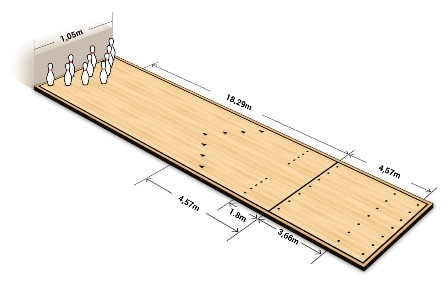

 |
Bowling Centers |  |
Home |
Bowling Equipment |
Professionals |
 |
Bowling AlleyA typical bowling alley can vary in size and the amount of lanes they have. Some bowling centers may have as few as one to two pairs of lanes while other centers may have as many as fifty pairs of lanes (totaling one hundred lanes). |
 |
Bowling LaneThe image on the left displays the regulation lane setup. ApproachThe approach is the 4.75m section of the lane and is typically where the bowler stands and moves when throwing the bowling ball. Each of the dots on the approach is lined up with each of the facing pins at the end of the lane. Bowlers use these dots to figure out where they need to stand. Foul LineThis is the line after the approach that signifies a location that the bowler cannot cross. If a bowler does cross the foul line then the bowler takes a penalty. Main Lane SectionThe lane itself stretches from the foul line to the head pin which is 18.29m in length. This is the section the lane travels on and is covered in oil to help with traction. The arrows are aiming markers for the bowler to aim for when they release the ball. Bowlers often number these arrows from 1 to 7 from left to right or vice-versa depending on if your right or left handed. Pin DeckThe pin deck is where the pins sit after the main section of the lane. Pins are labeled with numbers from 1 to 10 with the head pin being number one. The two pin is the pin to the left of the head pin with the three pin being to the right of the head pin. The area between the one and two pin and between the one and three pin is called the "pocket" because it is the location that is most effective when trying to get a strike. |